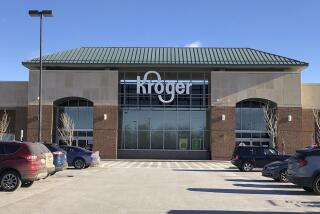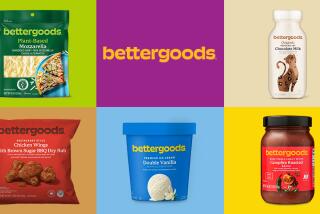Product Swapping, Switching : Sometimes You Get What You Pay for . . . and Sometimes You Don’t
- Share via
Labels cover a multitude of sins when it comes to the packaging and marketing of national brands, store brands and generics. If food manufacturers were asked to “bare all,” there’d be a lot of embarrassed advertisers--and a lot of surprised consumers.
Product swapping, label switching and recipe imitating are common among manufacturers and packers. The result is a marketplace of products that may be more alike--or, depending on your viewpoint, more different--than one might think.
What You Get
Sometimes you get what you pay for. Sometimes you don’t. For example:
--Some of Safeway’s Town House brand canned fruits are packed by Del Monte. Same product, according to Safeway. The only difference is the label and the price.
--On the other hand, Del Monte only packs the center portion, or fillet, of the green bean under its own name. The company then packs the end cuts of the beans for house brands with specifications that aren’t as high as Del Monte’s.
--There are only three manufacturers in the instant breakfast business in this country--Carnation, Pillsbury and a company called Dean Foods. If an instant breakfast label says anything but Carnation or Pillsbury, it was manufactured by Dean, the only private-label packager of the product in the country. Different labels, all the same product.
--H. J. Heinz Co., which no longer sells soup under its own name, manufactures 95% of this country’s store-brand soups. Safeway brand soups are made by Heinz.
--Land O’Lakes manufactures an instant nonfat dry milk under the label Flash. Since there is not much variation in how nonfat dry milk is processed, the company takes the same product and packages it in a plain black-and-white generic box. Cost to the consumer: about 15 cents less per box.
Differences in Quality
The quality of generics may vary according to whose odds and ends are being used. Maybe Campbell’s has had leftovers one time, maybe next time it’s Van de Kamp’s, says Richard Goldsmith, manager at a Silver Spring, Md., Foodtown store that sells generics.
There are no stringent rules covering national, store or generic brands. Who packs what and what label ends up on it is highly variable. Many national-brand manufacturers pack a line of store brands, so in fact the two products may be identical; some national brands pack a generic line that is in fact a lower-grade product; some store brands are packed by private-label packers; others may be made right at a store plant. You just don’t know.
Confusing the issue even more is the fact that government standards--while they may be painstakingly detailed about what constitutes a “fancy,” “standard” or “extra-standard” peach, for example--require that packers conform to those grades only if they choose to label them as such. That means that a store brand’s canned peaches could potentially contain a higher-grade peach than a national manufacturer, although you might not be able to tell from the label.
And then there’s the commodities market, which fluctuates from year to year. If it’s a terrific year for a particular crop, the price will be low, and “everyone can afford the good stuff,” says Mina Williams, consumer affairs adviser for the Private Label Manufacturers Assn., a trade group that represents manufacturers of store brands. For example, since there is a raisin glut this year, those raisins with the “proper shrivel” and the sweetest tastes should be available to national brand, store brand and generic packers alike. The steak sauce companies and the chutney manufacturers may be getting the residual, Williams said.
What most industry experts will agree upon, however, is that store brands and national brands are more similar to each other than generics, which are generally a lower grade.
Decline in Demand for Generics
In the last few years, however, there has been a shift in the generic trend. The generic heyday that started in the late ‘70s, bringing an influx of non-advertised, no-frills black-and-white-packaged products to the supermarket, is experiencing a steady decline.
According to Alan Miller of Sales Area Marketing Inc., a company that tracks buying trends, generics are “gradually phasing out,” now accounting for 2.2% of dollar sales of all food products, down from its peak of 2.6% in March of 1983. Miller attributes the decline to the decrease in the inflation rate, although he added that there will always be generics in certain product categories, such as paper towels, sugar or salt.
Some new product categories or “sub-product” categories have entered the market as well, creating confusion as to just what a store brand or generic is. For instance, several chains now stock products that industry experts have coined “neogenerics,” “second-generation generics” or “second-tier store brands.” These are products aimed to compete with generics, although not packaged as such. Safeway, for instance, sells a Scotch Buy brand, which is comparable to a generic product.
Everyone knows the national brands; obviously that is the purpose of advertising. And while many chains have their own store brands that are readily recognizeable, some are not. Safeway, for instance, has a total of 40 store brands, although some are not in frequent use.
Although many national brands also turn out private labels (house brands), they don’t publicize the fact, according to Miller of Sales Area Marketing, for obvious reasons: It would make advertising moot, plus it would pit a major manufacturer against itself.
Big Business in Private Labels
But private-label manufacturing can be a big business for big manufacturers. In fact, some national brand companies have separate divisions that deal exclusively with private-label sales. Heinz, for instance, has a private-label division that, besides manufacturing soups, puts private labels on its peppers, pickles and relish. For Heinz, the soup arrangement was ideal; the company used to manufacture soups under its own label, but “the market is pretty much saturated by another brand,” said Heinz spokeswoman Beth Adams. Heinz was able to take advantage of its facilities.
For other manufacturers, filling up plant capacity with a store brand or having an outlet for byproducts makes a lot of economic sense.
Although Williams of Private Label Manufacturers Assn. will not divulge specific examples of major manufacturers doing private labels, she said that in some product areas there just aren’t a lot of manufacturers. A few companies may be doing a lot of labels. “How many aluminum foil companies do you think are out there? How many frozen-food packing plants could there be?” she said.
National-brand manufacturers counter the store brand issue by saying that consumers are assured consistent products under higher national-brand standards, that they don’t have to worry that the canned pears will be overripe or underripe or in pieces instead of uniform halves.
A representative for Del Monte said the company provides growers with seeds, and during the entire growing process it is constantly monitoring the crop to see “if it’s Del Monte material.” If it’s not, the label might read Grand Union or Kroger, two of the company’s private-label accounts. Yet depending on the criteria set by the chain, its standards--and resulting product--could be the same as Del Monte’s.
Unfortunately, because of all the factors involved, the only way to really tell the difference between name brand, store brand and generics is to rotate brands, says Stephen Brobeck, executive director of the Consumer Federation of America. But, said Brobeck, “we urge consumers to give store brands and generics a try.” Because national brands are advertised so heavily, consumers may buy them for the wrong reasons. They may think they’re superior to store brands, which they aren’t always, said Brobeck, or they may feel that it’s socially unacceptable to buy a product that doesn’t have national advertising recognition.
Savings Could Add Up
Michael Jacobson, director of the Center for Science in the Public Interest, calculated that consumers could save $7 a week if they stuck with store brands. The American public could save $35 billion a year, said Jacobson.
The national brand versus store versus generics decision also depends on how you will use the product. If you’re making chili, you may not care whether the kidney beans are of uniform size and color. But if it’s a three-bean salad, then you might want to be assured of a pretty bean, said Williams.
And a certain amount of product difference can be ascertained from the product label, says Williams. For instance, A&P;’s strawberry preserves lists as its ingredients: “strawberries, corn syrup, high fructose corn syrup, cane sugar, pectin, citric acid and sodium citrate as needed.” The second-tier store product, P&Q;, lists ingredients as follows: “corn syrup, strawberries, sugar, pectin, citric acid and sodium citrate as needed.” The A&P; brand contains more strawberries.
No matter what the product level, packaging plays a great deal on shopper perception. Barbara Ettinger of Safeway said that when the chain once changed the name and label on a line of canned tomatoes from Garden Way to Scotch Buy--while retaining the packer and the identical product--there were complaints. Consumers preferred the taste of Garden Way.
More to Read
Eat your way across L.A.
Get our weekly Tasting Notes newsletter for reviews, news and more.
You may occasionally receive promotional content from the Los Angeles Times.










